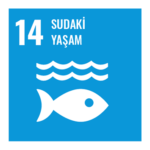Invasive alien species are the species that have been introduced to an ecosystem as a result of human activities and spread rapidly in the environment they settle, negatively affecting the environment, economy and human health. Species today are introduced rather rapidly through human activities of maritime trade and transport. There are almost 500 marine alien species identified to date on the coast of Turkey. All organisms, from the largest to the smallest, including fish, mussels, jellyfish, seaweeds and microscopic pathogens may be an invasive species.
Most effective methods to control marine invasive alien species include prevention before establishment and spread, early detection and response, keep under control and reduce rate of spread if they are established in a certain area.
What is an Alien Species?
Alien species (also known as non-indigenous or exotic species) are species that are introduced outside of their natural and potential distributional area by human activities.
Invasive Alien Species (IAS), are defined as established alien species which have spread, are spreading or have demonstrated their potential to spread elsewhere, and have an adverse effect on biological diversity, ecosystem functioning, socio-economic values and/or human health in invaded regions.
Alien species populations are kept under control in their natural habitats by many limiting factors as climate, resources, predators and diseases. Not every alien species is invasive. When alien species successfully establish and spread in a new environmeny, alter foodwebs and threaten biodiversity, harm human health and economy, they are called invasive species.
IUCN and CBD terminologies are compared and simplified.
How they are introduced?
Species have for ages been spreading to new environments by natural mechanisms (storms, oceanic streams etc.). Today however, species are introduced rather rapidly through human activities of maritime trade and transport. They particularly travel by adhesion to hulls of ships, yachts and vessels, and mostly in ballast waters.
Marine alien species are introduced by human activities accidentally or deliberately into a natural environment where they are not normally found. There are 500 marine alien species identified to date in Turkish seas. Further, 1 new marine alien species is introduced every 4 weeks into Turkish seas. It is reported that 2/3 of species introduced to Turkish seas arrived from the Red Sea to the Mediterranean via Suez Canal, and 1/3 on hulls and in ballast waters.
Turkish waters have 3 invasive alien species (comb jelly, veined whelk, and water hyacinth) listed in “100 of the World’s Worst Invasive Alien Species List” by the International Union for Conservation of Nature (IUCN).
How we recognize?
All living creatures from the largest to smallest, fish, mussels, jellyfishes, seaweed and microscopic pathogens can be invaders. There are approximately 500 marine alien species spotted in Turkish seas to date. Most of these species are of Indo-Pacific origin that entered through the Suez Canal due to the effects of climate change.
Four invasive species (comb jelly, veined Rapa whelk, Caulerpa seaweed and water hyacinth) from the list of 100 world’s worst invasive alien species published by the International Union for Conservation of Nature (IUCN) are present in Turkish seas.
For more information on marine invasive alien species, see Marine Invasive Alien Species Catalogue
Beware: Most dangerous invaders
- Comb jellyfish (damages local food chains, reduces fish stocks, affects fishing and tourism activities)
- Veined Rapa whelk (damages local food network, reduces mussel, oyster and fish stocks)
- Caulerpa seaweed (threatens seagrasses, adversely affects diving tourism by damaging the seafloor)
- Water hyacinth (water hyacinth waste coming from the Orontes river prevents green sea turtle hatchlings from reaching seawater as they are entangled in water hyacinth waste)
Keep Away: Most poisonous invaders
- Elongated puffer (reduces mollusc population such as squid and octopus, affects fishing activities, and harms human health)
- Spinefoot (venomous, has economic value)
- Lionfish (causes envenomation in human beings)
- Venomous invertebrates (sea urchin, bearded fireworm, jellyfish)
What are their impacts?
Small in size, big in impact: Marine invasive alien species
Marine invasive alien species adversely affect marine ecosystems, human health and well-being and economy. They have numerous environmental, social, economic impacts.
Environmental impacts: Marine invasive alien species alter marine food-webs and cause degradation of marine biodiversity. They particularly prey on native species, compete with native species for space and food, alter and destroy the habitat where they establish, and carry parasites and diseases.
Impacts on human health and well-being (social impacts): Some marine invasive alien species are poisonous and harmful to human health when touched or consumed. Some may transmit diseases and parasites to native species. Pathogens like cholera microbe (Vibrio cholerae) that are introduced by ship’s ballast waters cause diseases in humans. In respect of fishing, they cause reduction in fish stocks and tear fishnets. In respect of tourism activities, such species as jellyfish pose dangers in swimming and diving; the sea bottom may become barren to such extent that it is no longer attractive to dive. This adversely impact fishing and tourism as most important livelihoods of local people. Such species are also harmful to social and cultural benefits (ecosystem services) offered by marine ecosystems to human beings.
Economic impacts: Marine invasive alien species cause the loss of environmental and social benefits offered by marine ecosystems to human beings. They may cause loss of livelihoods and unemployment. When they establish and spread in a certain area, significant investments and costs are needed to keep their population under control and reduce their rate of spread. They cause problems in coastal infrastructure such as clogging of water pipes and damage to treatment facilities.
Why we should control?
Effective control of marine invasive alien species, healthy seas and healthy human beings
Environmental; Protects marine ecosystems and biodiversity.
Social; Protects livelihoods supporting human health and well-being, preserves social and cultural benefits offered by marine ecosystems to human beings.
Economic; Prevents costs and economic losses caused by marine invasive alien species.
What is being done and can be done?
Learn about and support the control of marine invasive alien species
The most effective strategy is to prevent before marine invasive species establish and spread because once they are spread, it is extremely difficult to control and reduce, and costs are high.
PREVENT
Ballast water management is crucial in preventing the introduction of marine invasive alien species by maritime trade and transport; so is the implementation of biosafety rules in preventing the same by aquaculture and aquarium trade. Further, engaging people in such efforts will help them access information on marine invasive alien species and monitor the trends.
DETECT EARLY AND INTERVENE
Studies, surveillance and monitoring activities are extremely important in early detection and intervention before marine invasive alien species spread. This requires setting up and operating early warning and intervention systems.
CONTROL AND REDUCE
When marine invasive alien species establish in a certain area, it is important keep their population under control and reduce their rate of spread.
What can we do?
- Learn more about marine invasive alien species and their impacts.
- Support us by monitoring changes in the seas, detecting and notifying marine invasive alien species.
- Check the hulls of fishing and cruise boats, fishing and diving equipment, clean and dry before using again.
- Never discharge fish ponds, decorative ponds or aquaria in natural water or wastewater sites. Remember that many urban wastewater systems may release organisms into seas.
All efforts to protect marine ecosystems and biodiversity will also support the control of marine invasive alien species.
Visit the following websites on good practices of controlling marine invasive alien species in the world:
- European Commission IAS (Invasive Alien Species – Environment – European Commission)
- IEEP EU (Invasive Alien Species)

